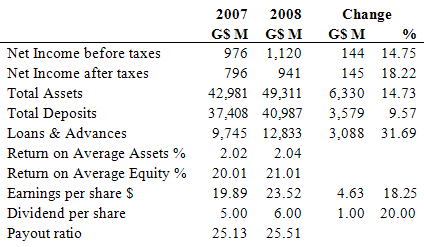Guest business column by Robert V McRae, CPA
Background
Several weeks ago the Bank of Guyana (BoG) publicly and the Guyana Bank for Trade and Industry (GBTI) management privately in a letter to me, responded to a guest Business Page published in Stabroek News of April 12, 2009 under my name. Unfortunately, personal commitments precluded me from addressing this matter earlier and for this I apologise.
Of specific concern to both entities were two paragraphs under the caption ‘The blog and the BoG.’ The two paragraphs contained information derived from the Annual Report of the bank and merely raised legitimate questions over the original response to the blog, particularly why it did not acknowledge the overnight borrowing by the bank or the deficiency in the statutory reserve requirement of more than $4B at December 31, 2008. After the column had raised the matter the Bank of Guyana advised that the shortfall was “authorised,” a fact that was not evident prior to its public statement.
Overnight borrowing
While the BoG must be commended for its prompt dispelling of any doubt surrounding the bailout claim, it should have at the time acknowledged the approach for the overnight facility while asserting that transactions of a similar nature were not unusual. This was clearly an unnecessary and unfortunate omission that did little to help the cause it was seeking to promote.
In its direct response to me, the management of GBTI has correctly made the point that the BoG’s half year report 2008 reveals sixty-three trades in the inter-bank market with the value of funds traded totalling $20.4B. It is of interest to note that the average value of these trades is approximately $324M, so in terms of its magnitude, that specific transaction of $1.5B by itself must be considered unique and therefore warranting more explanation than was provided.
Reserve requirement deficiency
The second issue and the reference to the deficiency in the reserve requirement was that maintenance of this reserve is a statutory requirement and nowhere in the financial statements could the reader deduce from what date or why this shortfall had occurred, nor was there any indication whether the situation had been corrected, as was the case in the Bank’s 2007 annual report, (It has since been revealed by the BoG press release that the 2008 shortfall was corrected.)
Indeed, financial reporting standards which specify that, “if the quantitative data disclosed at the end of the reporting period are unrepresentative of the company’s exposure to risk during the period, an entity shall provide further information that is representative,” would seem to make such disclosures mandatory – another unhelpful omission.
Bank of Guyana press release
The press release also refers to discretion which the Bank of Guyana is allowed to exercise in these matters. As far as this writer is aware, discretion exists in the relevant legislation only with respect to the imposition of penalties for deficiency in the reserve requirement, and does not allow for authorisation of what is tantamount to a breach of law. Consequently it appears that the BoG acted without authority.
In the current economic climate the BoG must not only be seen to be acting promptly but it must also act impartially, and if it does engage in a public issue it must ensure it does so fully, fairly and completely.
It would have been extremely helpful and enlightening for BoG to have addressed the following:
1. The number of shortfalls in reserve requirements during 2007 and 2008 and the number of entities involved.
2. The circumstances in which BOG would “approve” a breach of the statutory reserve requirement by a financial institution.
3. GBTI management has indicated that the transactions resulting in the reserve requirement deficiency at the end of 2007 and 2008 were similar. The BoG should confirm whether it granted a similar “approval” in 2007 for the breach of the reserve requirement, and cite the specific authority for any such approval.
Conclusion
Nowhere in the earlier column was there any attempt to give credence to the spurious claim by the blog that the GBTI required a bailout, nor any question raised about the financial soundness of the bank.
As a public company, whether the management of GBTI disapproves or not, any member of the public is entitled to seek clarification of any matter on which there is inadequate or no information. Financial statements are only as good as the information they contain and the users can only draw conclusions based on what is disclosed. Rather than leave unanswered questions, the management of all public companies and most especially financial institutions should lean towards more helpful rather than less disclosure unless confidentiality or competitiveness will be compromised.
The questions raised in the article go to the heart of transparency, accountability and fairness. The BoG must avoid any appearance that it favours one institution over others and ought not to overlook, in matters of this nature, the implications for its role as an independent, supervisory watchdog over the sector.

